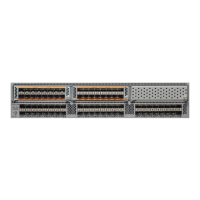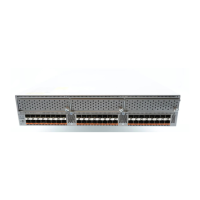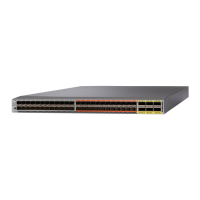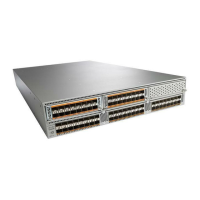Send feedback to nx5000-docfeedback@cisco.com
1-19
Cisco Nexus 5000 Series Switch CLI Software Configuration Guide
OL-16597-01
Chapter 1 Configuring and Managing Zones
Enhanced Zoning
About Enhanced Zoning
Table 1-2 lists the advantages of the enhanced zoning feature in all switches in the Cisco Nexus 5000
Series.
Changing from Basic Zoning to Enhanced Zoning
To change to the enhanced zoning mode from the basic mode, perform this task:
Step 1 Verify that all switches in the fabric are capable of working in the enhanced mode.
If one or more switches are not capable of working in enhanced mode, then your request to move to
enhanced mode is rejected.
Step 2 Set the operation mode to enhanced zoning mode.
You will automatically start a session, acquire a fabric wide lock, distribute the active and full zoning
database using the enhanced zoning data structures, distribute zoning policies and then release the lock.
All switches in the fabric then move to the enhanced zoning mode.
Table 1-2 Advantages of Enhanced Zoning
Basic Zoning Enhanced Zoning Enhanced Zoning Advantages
Administrators can make simultaneous
configuration changes. Upon activation, one
administrator can overwrite another administrator’s
changes.
Performs all configurations within a
single configuration session. When you
begin a session, the switch locks the
entire fabric to implement the change.
One configuration session for
the entire fabric to ensure
consistency within the fabric.
If a zone is part of multiple zone sets, you create an
instance of this zone in each zone set
References to the zone are used by the
zone sets as required once you define
the zone.
Reduced payload size as the
zone is referenced. The size
is more pronounced with
bigger databases.
The default zone policy is defined per switch. To
ensure smooth fabric operation, all switches in the
fabric must have the same default zone setting.
Enforces and exchanges the default
zone setting throughout the fabric.
Fabric-wide policy
enforcement reduces
troubleshooting time.
To retrieve the results of the activation on a per
switch basis, the managing switch provides a
combined status about the activation. It does not
identify the failure switch.
Retrieves the activation results and the
nature of the problem from each remote
switch.
Enhanced error reporting
eases the troubleshooting
process
To distribute the zoning database, you must
reactivate the same zone set. The reactivation may
affect hardware changes for hard zoning on the local
switch and on remote switches.
Implements changes to the zoning
database and distributes it without
reactivation.
Distribution of zone sets
without activation avoids
hardware changes for hard
zoning in the switches.
The Cisco-specific zone member types (symbolic
node name, and other types) may be used by other
non-Cisco switches. During a merge, the
Cisco-specific types can be misunderstood by the
non-Cisco switches.
Provides a vendor ID along with a
vendor-specific type value to uniquely
identify a member type.
Unique vendor type.
The fWWN-based zone membership is only
supported in Cisco interop mode.
Supports fWWN-based membership in
the standard interop mode (interop
mode 1).
The fWWN-based member
type is standardized.

